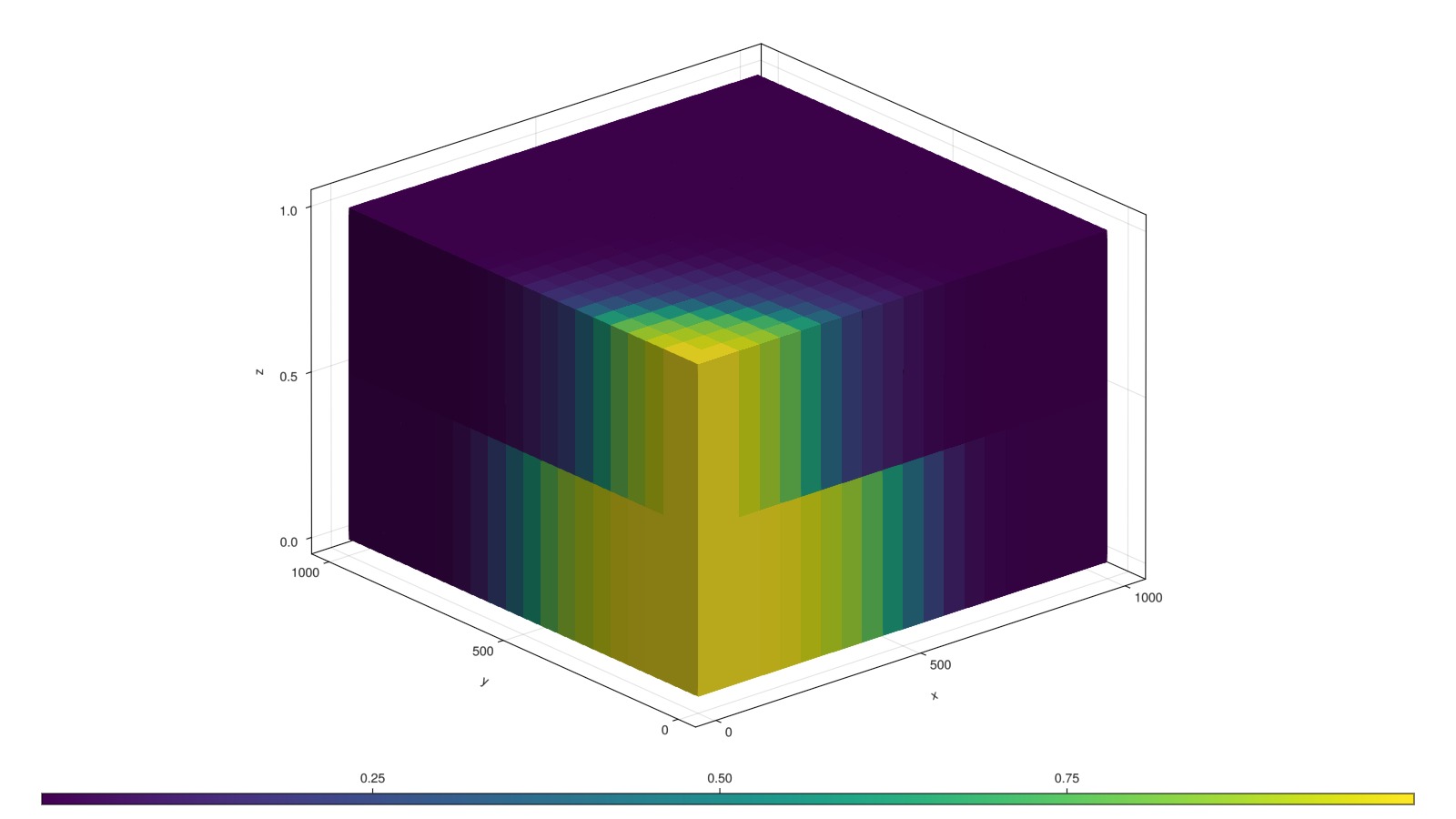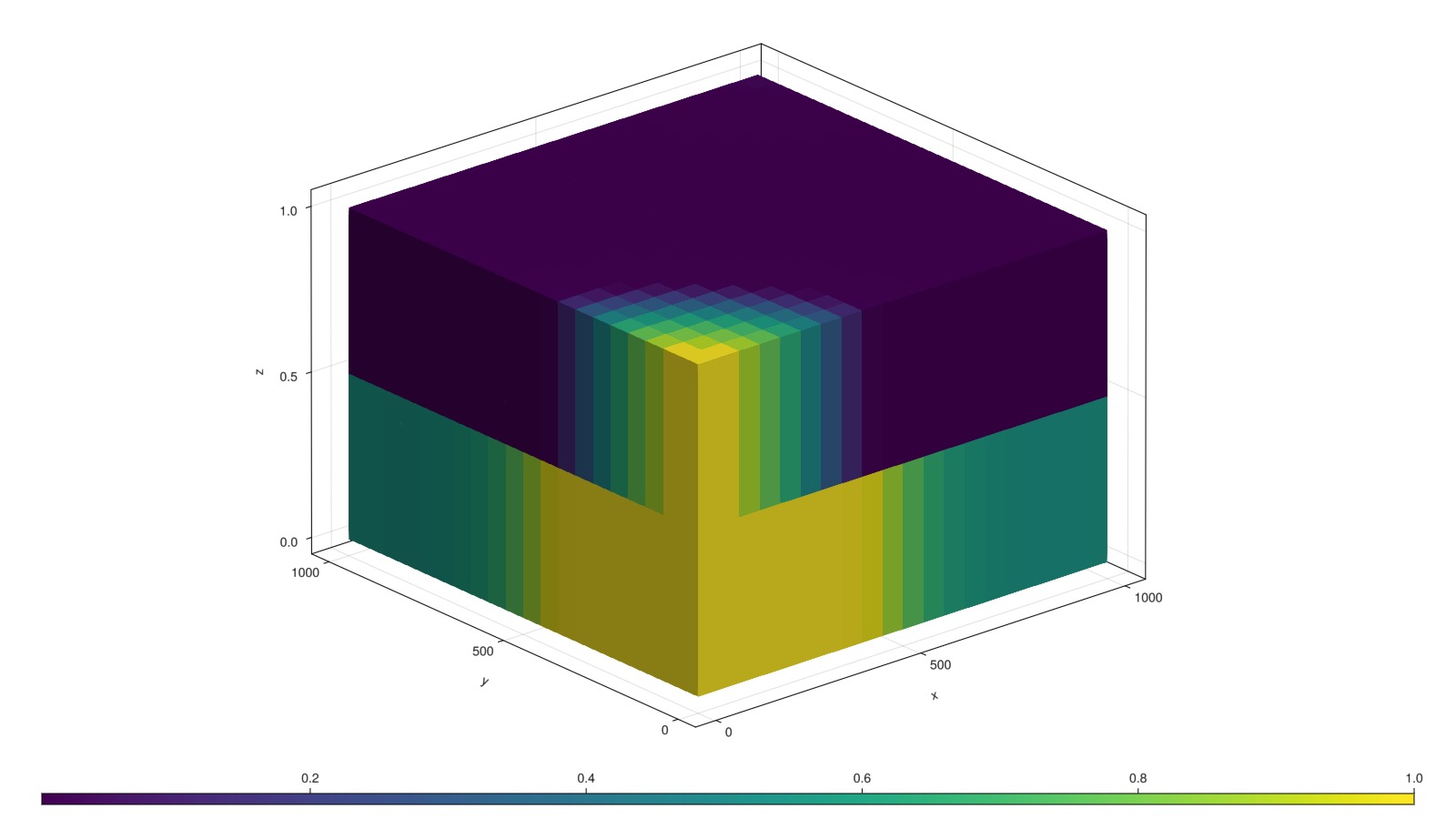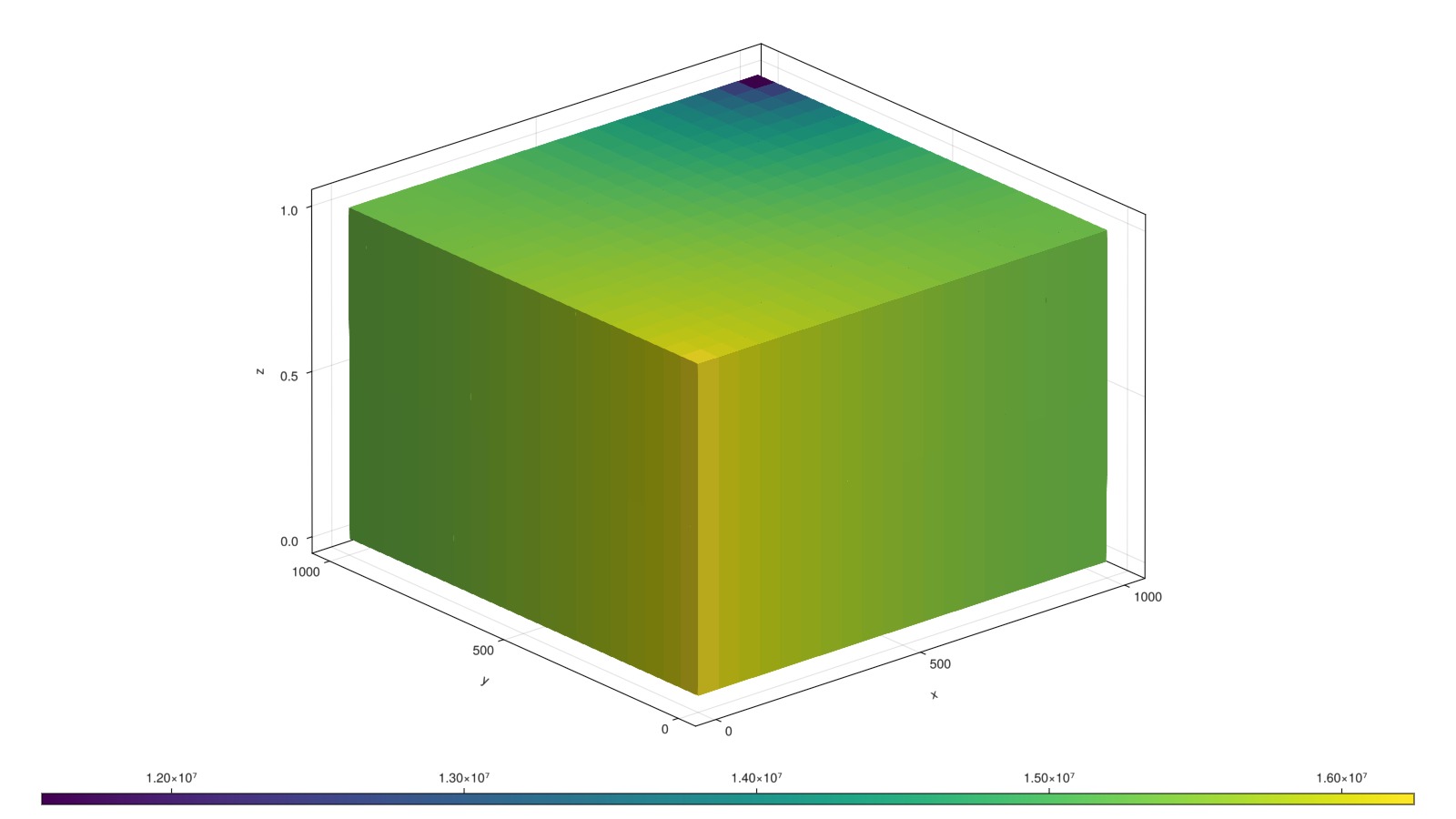A more complex compositional model
This example sets up a more complex compositional simulation with five different components. Other than that, the example is similar to the others that include wells and is therefore not commented in great detail.
julia
using MultiComponentFlash
n2_ch4 = MolecularProperty(0.0161594, 4.58e6, 189.515, 9.9701e-05, 0.00854)
co2 = MolecularProperty(0.04401, 7.3866e6, 304.200, 9.2634e-05, 0.228)
c2_5 = MolecularProperty(0.0455725, 4.0955e6, 387.607, 2.1708e-04, 0.16733)
c6_13 = MolecularProperty(0.117740, 3.345e6, 597.497, 3.8116e-04, 0.38609)
c14_24 = MolecularProperty(0.248827, 1.768e6, 698.515, 7.2141e-04, 0.80784)
bic = [0.11883 0.00070981 0.00077754 0.01 0.011;
0.00070981 0.15 0.15 0.15 0.15;
0.00077754 0.15 0 0 0;
0.01 0.15 0 0 0;
0.011 0.15 0 0 0]
mixture = MultiComponentMixture([n2_ch4, co2, c2_5, c6_13, c14_24], A_ij = bic, names = ["N2-CH4", "CO2", "C2-5", "C6-13", "C14-24"])
eos = GenericCubicEOS(mixture, PengRobinson())
using Jutul, JutulDarcy, GLMakie
Darcy, bar, kg, meter, Kelvin, day = si_units(:darcy, :bar, :kilogram, :meter, :Kelvin, :day)
nx = ny = 20
nz = 2
dims = (nx, ny, nz)
g = CartesianMesh(dims, (1000.0, 1000.0, 1.0))
nc = number_of_cells(g)
K = repeat([0.05*Darcy], 1, nc)
res = reservoir_domain(g, porosity = 0.25, permeability = K, temperature = 387.45*Kelvin)DataDomain wrapping CartesianMesh (3D) with 20x20x2=800 cells with 18 data fields added:
800 Cells
:permeability => 1×800 Matrix{Float64}
:porosity => 800 Vector{Float64}
:rock_thermal_conductivity => 800 Vector{Float64}
:fluid_thermal_conductivity => 800 Vector{Float64}
:rock_density => 800 Vector{Float64}
:temperature => 800 Vector{Float64}
:cell_centroids => 3×800 Matrix{Float64}
:volumes => 800 Vector{Float64}
1920 Faces
:neighbors => 2×1920 Matrix{Int64}
:areas => 1920 Vector{Float64}
:normals => 3×1920 Matrix{Float64}
:face_centroids => 3×1920 Matrix{Float64}
3840 HalfFaces
:half_face_cells => 3840 Vector{Int64}
:half_face_faces => 3840 Vector{Int64}
960 BoundaryFaces
:boundary_areas => 960 Vector{Float64}
:boundary_centroids => 3×960 Matrix{Float64}
:boundary_normals => 3×960 Matrix{Float64}
:boundary_neighbors => 960 Vector{Int64}Set up a vertical well in the first corner, perforated in all layers
julia
prod = setup_vertical_well(g, K, nx, ny, name = :Producer)MultiSegmentWell [Producer] (3 nodes, 2 segments, 2 perforations)Set up an injector in the opposite corner, perforated in all layers
julia
inj = setup_vertical_well(g, K, 1, 1, name = :Injector)
rhoLS = 1000.0*kg/meter^3
rhoVS = 100.0*kg/meter^3
rhoS = [rhoLS, rhoVS]
L, V = LiquidPhase(), VaporPhase()(LiquidPhase(), VaporPhase())Define system and realize on grid
julia
sys = MultiPhaseCompositionalSystemLV(eos, (L, V))
model, parameters = setup_reservoir_model(res, sys, wells = [inj, prod], block_backend = true);
kr = BrooksCoreyRelativePermeabilities(sys, 2.0, 0.0, 1.0)
model = replace_variables!(model, RelativePermeabilities = kr)
push!(model[:Reservoir].output_variables, :Saturations)
state0 = setup_reservoir_state(model, Pressure = 225*bar, OverallMoleFractions = [0.463, 0.01640, 0.20520, 0.19108, 0.12432]);
dt = repeat([2.0]*day, 365)
rate_target = TotalRateTarget(0.0015)
I_ctrl = InjectorControl(rate_target, [0, 1, 0, 0, 0], density = rhoVS)
bhp_target = BottomHolePressureTarget(100*bar)
P_ctrl = ProducerControl(bhp_target)
controls = Dict()
controls[:Injector] = I_ctrl
controls[:Producer] = P_ctrl
forces = setup_reservoir_forces(model, control = controls)
ws, states = simulate_reservoir(state0, model, dt, parameters = parameters, forces = forces)ReservoirSimResult with 365 entries:
wells (2 present):
:Producer
:Injector
Results per well:
:orat => Vector{Float64} of size (365,)
:N2-CH4_mass_rate => Vector{Float64} of size (365,)
:C6-13_mass_rate => Vector{Float64} of size (365,)
:C14-24_mass_rate => Vector{Float64} of size (365,)
:C2-5_mass_rate => Vector{Float64} of size (365,)
:bhp => Vector{Float64} of size (365,)
:lrat => Vector{Float64} of size (365,)
:CO2_mass_rate => Vector{Float64} of size (365,)
:mass_rate => Vector{Float64} of size (365,)
:rate => Vector{Float64} of size (365,)
:control => Vector{Symbol} of size (365,)
:grat => Vector{Float64} of size (365,)
states (Vector with 365 entries, reservoir variables for each state)
:LiquidMassFractions => Matrix{Float64} of size (5, 800)
:OverallMoleFractions => Matrix{Float64} of size (5, 800)
:Saturations => Matrix{Float64} of size (2, 800)
:Pressure => Vector{Float64} of size (800,)
:VaporMassFractions => Matrix{Float64} of size (5, 800)
:TotalMasses => Matrix{Float64} of size (5, 800)
time (report time for each state)
Vector{Float64} of length 365
result (extended states, reports)
SimResult with 365 entries
extra
Dict{Any, Any} with keys :simulator, :config
Completed at Oct. 01 2024 16:10 after 44 seconds, 807 milliseconds, 297.5 microseconds.Once the simulation is done, we can plot the states
CO2 mole fraction
julia
sg = states[end][:OverallMoleFractions][2, :]
fig, ax, p = plot_cell_data(g, sg)
fig
Gas saturation
julia
sg = states[end][:Saturations][2, :]
fig, ax, p = plot_cell_data(g, sg)
fig
Pressure
julia
p = states[end][:Pressure]
fig, ax, p = plot_cell_data(g, p)
fig
Example on GitHub
If you would like to run this example yourself, it can be downloaded from the JutulDarcy.jl GitHub repository as a script, or as a Jupyter Notebook
This page was generated using Literate.jl.